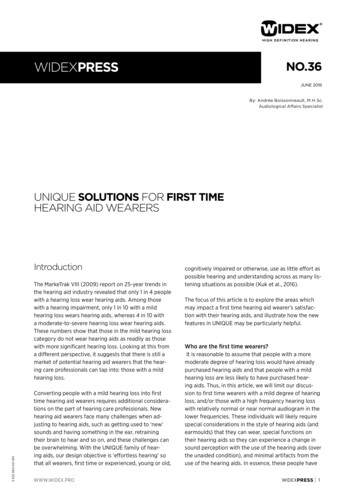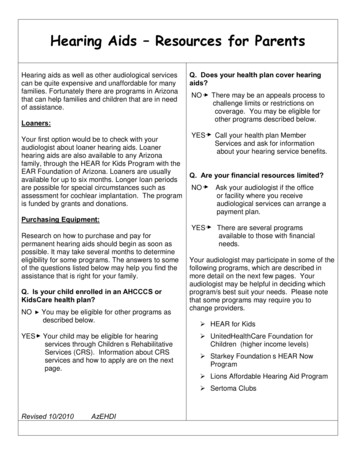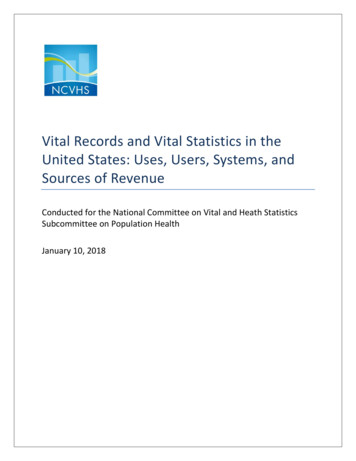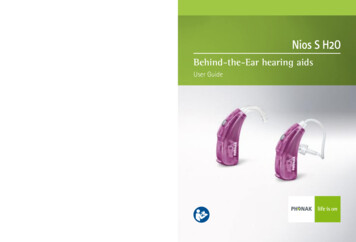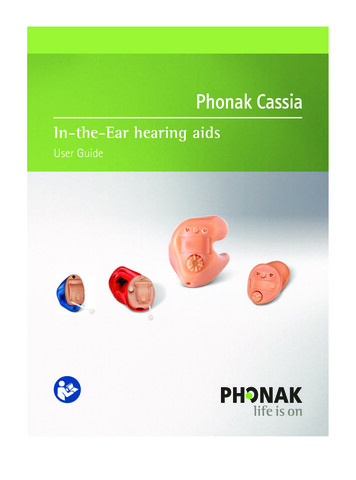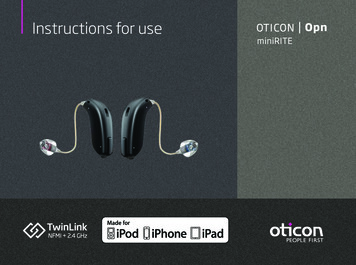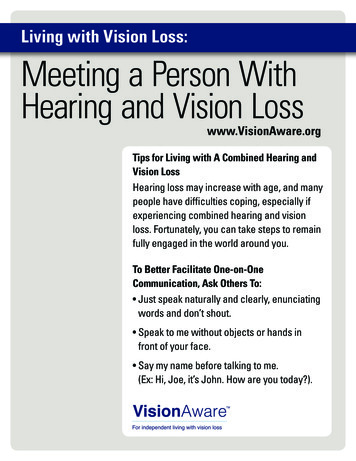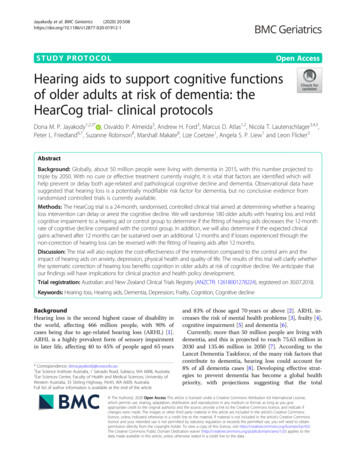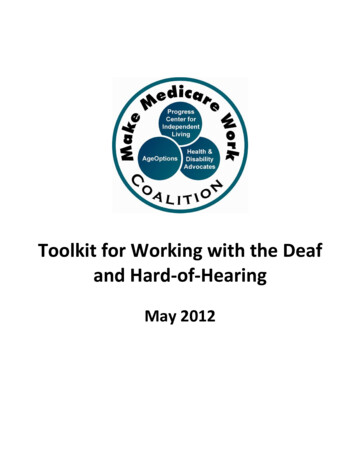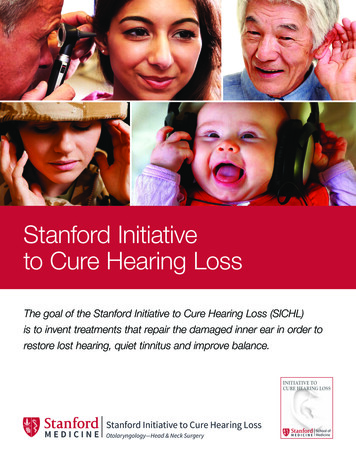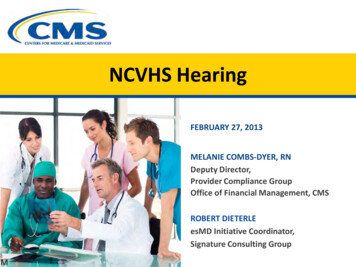
Transcription
NCVHS HearingFEBRUARY 27, 2013MELANIE COMBS-DYER, RNDeputy Director,Provider Compliance GroupOffice of Financial Management, CMSROBERT DIETERLEesMD Initiative Coordinator,Signature Consulting GroupM
esMD BackgroundBefore esMD:RequestLetterReview ContractorPaper MedicalRecordProviderProviderHealthcare payers frequently request thatproviders submit additional medicaldocumentation to support a specific claim(s).Until recently, this has been an entirely paperprocess and has proven to be burdensome dueto the time, resources, and cost to support apaper system.Phase 1 of esMD wasimplemented inSeptember of 2011. Itenabled Providers toelectronically submitmedical documentation toMedical ReviewContractors.Phase 1:Doc’nRequestLetterelectronicMPhase 2 of esMD is envisioned forthe future. It will enable ReviewContractors to send electronicmedical documentation requests toproviders.Phase 2:electronicelectronic2
esMD Process FlowThe overall esMD process can be divided into three steps: A provider registerswith a payer to receiveelectronic medicaldocumentationrequests (eMDRs)2. Send eMDRs A payer sends an eMDRto a registered provider1. Register toReceive eMDRsMesMD Phase 2 A providerelectronically sendsmedical documentationto a payer in responseto an eMDR3. Send MedicalDocumentationesMD Phase 13
Attachment StandardsM4
Are there multiple definitions of ‘attachments’ underdiscussion, and what is the recommended definition? Yes; all of the following use cases involve “attachments”: Prior Authorization -- such as for Power Mobility Devices (PMD) Pre-payment review Post payment review The CMS esMD team recommends that the definition of“attachments” include: Structured data in a standard exchange format (e.g. C-CDA) Unstructured data in PDF format contained in a C-CDA envelope Metadata required to establish authorship (e.g. digital signature)M5
What are the priority business areas for which‘attachments’ are necessary? How is this expected tochange in the next 5 or 10 years?Priority Business Areas:Preventing improper payments from the Medicare trust fund through:postpayment reviewprepayment reviewprior authorization reviewItem/serviceis orderedItem delivered/service renderedClaimsubmittedPaymentissued The CMS esMD team predicts the timing of reviews to shift:M Less post payment reviewMore prepaymentMore prior authorization6
ROBERT DIETERLEesMD Initiative Coordinator,Signature Consulting Group7
What are the recommended approachesto the submission of ‘attachments’? Adopt two standard content formats for the submission of attachments Consolidated CDA for predominantly structured data PDF for unstructured documents in CDA envelope Standards for Message standards / wrappers ASC X12 277 IHE XDM/XDR IHE DSG Standards for Transmission protocols and operating rules CAQH Core (ASC X12) eHealth Exchange (ONC NwHIN Exchange/CONNECT) ONC DirectB8
What is the status of development of‘attachment’ User StoryCertificateAuthority Payer EntityContractors /IntermediariesProvider EntityesMD UC 1: Provider sMD UC 2: Secure eMDR TransmissionesMD AoR Level 1Digital Signature on Document BundleesMD eDoC / AoR Level 2Structured and UnstructuredDocumentation for Determination ofCoverage with Digital SignaturesCompleted esMD attachment standards1. esMD pdf attachment2. eMDR sign up attachment3. AoR Level1 (digital signature Provider(Individual orOrganization) All Actors obtain and maintain a nonrepudiation digital identityProvider registers for esMD (seeUC1)Payer requests documentation (seeUC2)Provider submits digitally signeddocument (bundle) to addressrequest by payerPayer validates the digitalcredentials, signature artifacts and,where appropriate, delegation ofrightsNext StepsProvider creates structured andunstructured documentation (eDoC)Provider digitally signs eachdocument ((AoR L2)In process attachment standards4. AoR Level 2 (digital signature on individual Documents)5. electronic Determination of Coverage (structuredand unstructured documentation requirements for specificuse cases)9
eDoC Workgroup FocuseDoCWorkgroupCharterUse CaseHarmonizationPilotsSub-WorkgroupsStructured Data Determine documentationrequirements Evaluate appropriateclinical elements Clinical VocabulariesDocumentation Templates Define template requirements Define template workflow Define EHR data capturerequirements Specify storage requirements Define CCDA templateConsolidated CDABStructured Data CaptureDecision Support Define rules to guidedocumentation Define rules to presentcovered alternatives Determine workflowissuesHealth eDecision10
Standard Conversion - CurrentCurrent Exchange/ConnectBIG for CAQH CORE/ X12Workflow for CAQH/X1211
Potential DirectAttachment Environment (Options)1212
Standards for Attachments Standards and implementation guides forstructured data exchange are currently beingdeveloped by CMS/ONC’s electronicDetermination of Coverage (eDoC) workgroup.Join and participate!http://wiki.siframework.org/esMD Electronic Determination of Coverage ONC/S&I approach - Identify the specific standards, map theuse case data models to the standards , identify the gaps andwork with the SDOs to resolve the gaps.B Other standards for unstructured data exchangedo exist. CMS should always be allowed to acceptdocumentation in PDF format.13
What metadata or pieces of information would benecessary to include in the envelope that isnot available today in the HL7 C-CDA? Digital Signature and Delegation of Rights artifacts toattest to authorship, modifications, review: Initially on the entire CDA (see esMD Author of RecordLevel 2) Eventually for individual segments or elements (seeesMD Author of Record Level 3) Other data elements related to: Routing, end-point, purpose of use clear source of each unstructured or structuredsegment and elementB14
Envelope and Transport Standards Enveloping standards should support the required content formats Digital Signature metadata other metadata as required work with all three transport standards. While one enveloping standard (e.g. XDM) may not be sufficient, the number of standardsshould be limited and their use well defined based on the above requirements. Transport standards that should be supported: CAQH CoreSupported by most payers and provider administrative systems eHealthExchange (e.g. ONC Exchange/CONNECT)Supported by health exchanges, federal agencies and large providers ONC DirectRequired by Stage 2 EHR Certification and provides secure low cost email styletransportB15
What is the set of attachment standards beingrecommended for adoption?The CMS esMD team recommends that thefollowing attachment standards be adopted: for unstructured attachments, adopt the esMD pdf standard (CDA envelope) for structured attachments, Badopt the standards that emerge from theCMS/ONC eDoC Initiative (focused on template CCDA)16
Are there any known limitations or gaps in therecommended standards? How will they beaddressed?UnstructuredDocumentsStructured DocumentsContentSpecificationBYes, there are general and usecase specific gaps – eDoC subworkgroup will addressNo gap in the standards, onlyin the contentYes, there are general and useStandardElements and case specific gaps – eDoC subworkgroup will addressVocabulariesN/ADigitalSignaturesYes, there is a generalattachment gap and AoR isworking on it.Yes, there is a general attachmentgap and AoR is working on it.17
Are the recommended standards (and operating rules, if any)applicable only to claim attachments, or will they beapplicable also to other types of attachments? Yes the standards should be applicable to all types ofattachments. For example, attachments should support: Prior Authorization Pre-payment review Post payment review Operating Rules may be specific to the use case Harmonization with attachments required for the provisionof care (e.g. Transition of care and Longitudinal Coordinationof Care) is encouragedB18
What are some of the most important business and technical issuessurrounding attachments for providers, health plans, and vendors, andhow would you recommend addressing them? The CMS esMD team recommends focusing on: Digital signatures on contributions, documents, and bundles Long term validation of digital signatures and delegation of rights Document modification / addendumThe above issues are the focus of the esMD Author of Record workgroup. Standards for transactions (orders, results) for signatures anddocumentation of services ordered / delivered Standardization of clinical data elements and their use Specification of associated clinical vocabularies / code setsThe above issues are the focus of the esMD electronic Determination ofCoverage workgroup.B19
State of the IndustryM20
What is the current state of industry with respect to theexchange of standard clinical information to supportadministrative or financial transactions?esMD is NOTMandatoryfor ProvidersDoc’ n edicareRecoveryAuditorsPDFCERTPERMPDFPDFMedicare Private NetworkContent Transport ServicesBaltimore Data CenterCONNECTCompatibleMIn FY 2012, esMD allowed:- 1,778 providers to send- 85,000 medical records (in pdf format) via- 16 Health Information Handlers (HIHs) to- 21 CMS Review ContractorsIn the first 4 months of FY2013, over 90,000 medical records have been sent21
What problems or repercussions occur because of the currentstate? How would these be addressed if this process wasstandardized? esMD is well liked by facilities and other large providers but remains an expensive option for small providers Direct may help to provide a low cost, secure transport. Structure will be there for a meaningful use perspective. esMD helps reduce print/mail costs of large providers and CMS reviewcontractors but pdf formats must be reviewed by humans Structured document requirements emerging from eDoC workgroup willhelp. Most ordering physicians still rely on paper orders being faxed or handcarried to service suppliers, DMEs , therapists, HHAs etc.M eDoC and other ONC S&I Framework Initiative standards will promote theelectronic exchange of structured documentation, orders and care plansamong providers and suppliers.22
Overall, what would you say are the most significant benefits weshould expect to see (i.e., efficiency, quality, safety, economic, other)that we can rely upon to monitor progress and measure success? Most significant benefits Reduction in administrative cost to provider and payeroReduction in manual documentation submissionoFrequency of digital signatures on submitted documentationoFrequency of structured information used to determine coverage Reduction in inappropriate payments Reduction in turnaround time to authorize / pay claim Improve the consistency of reviews using computerizeddocumentation screening tools Most challenging benefits to realize Consistency of adoption across all payers and providers Funding needed to make the enhancements (during a time ofbudget cutbacks)M23
How would use of existing infrastructure or infrastructurethat will be in place by 2016 impact costs and savings?ValueMStatusesMD Phase 1 (electronic PDFsubmission) CONNECTIncrease utilization for esMD and other CMS initiatives-- reduce provider and CMS costProductionDirectSecure / Low Cost transport -- reduce administrativecost – take advantage of Stage 2 EHR requirements2013 PilotCAQH Core / esMDSupport X12 and CAQH core operating rules for portionof industry that adoptsTBDProvider RegistrationMeet HIPAA requirements to send PHI from CMS toprovidersFuture PilotElectronic MedicalDocumentation RequestsEliminate paper requests and provide basis forautomation of provider responseFuturePilotProvider Registry (to sign upfor eMDRs)Determine electronic endpoints (ESI) for providers andpayers – reduce burden to maintain currentinformationFuturePilot24
How would use of existing infrastructure or infrastructure that will bein place by 2016 impact costs and savings? Providers, health plans andvendors are asked to speak about this from their individualperspectives.ValueStatusAuthor of Record -- DigitalSignatures on attestationsand document bundles)Replace wet signatures with digital signatures reduceunreadable signatures and administrative burdenFuture PilotAuthor of Record -- DigitalSignatures on DocumentsProvide proof of actions on individual documents /orders – reduce administrative time and cost2013 Pilot on PMDprogress notes &ordersAuthor of Record -- DigitalSignatures on ContributionsProvide proof of actions on multi-author documents– reduce administrative time and costPossible2014-2016 PilotsElectronic Determination ofCoverage (structured data)Structured documentation and order standards forhigh cost services – reduce inappropriate payment2013/2014 Pilot onprogress notes &ordersElectronic Determination ofCoverage (eTemplates)Reduce the burden to ensure completedocumentation for determination of overage2013/2014 Pilot onprogress notes &ordersElectronic Determination ofCoverage (decision support)Improve provider documentation for complex casesand guide selection of covered servicesFuture PilotM25
QuestionsM26
The overall esMD process can be divided into three steps: A provider registers with a payer to receive electronic medical documentation requests (eMDRs) 1. Register to Receive eMDRs A payer sends an eMDR to a registered provider 2. Send eMDRs A provider electronically sends medical documentation to a payer in response to an eMDR 3.
